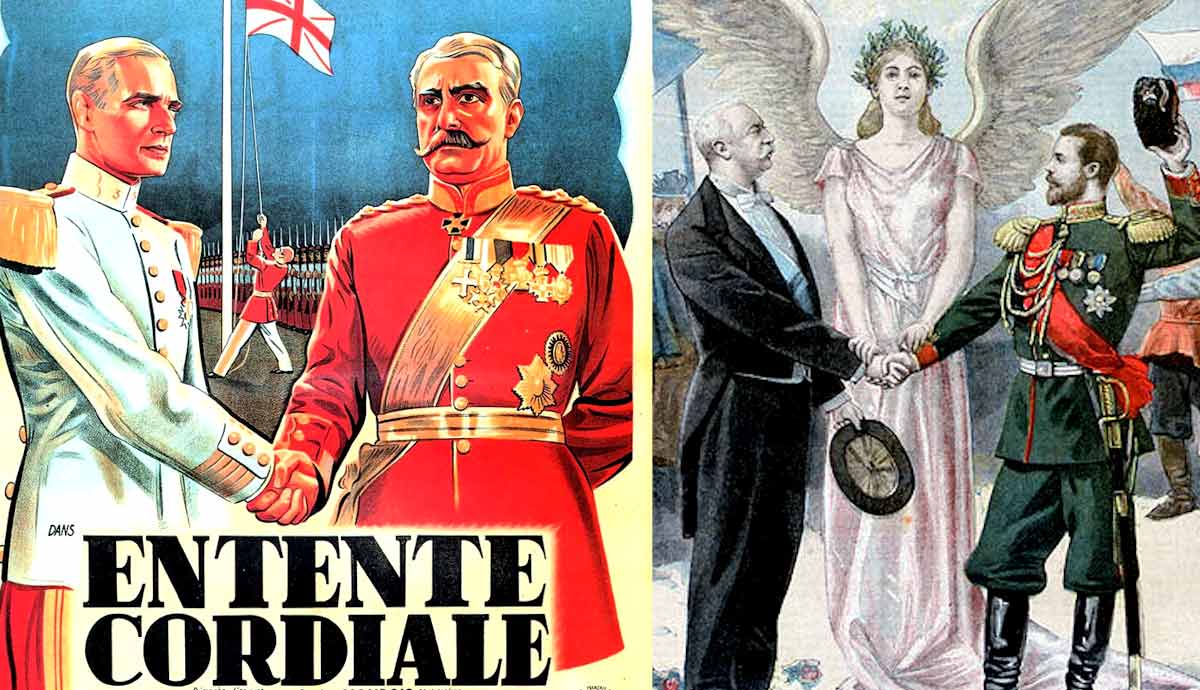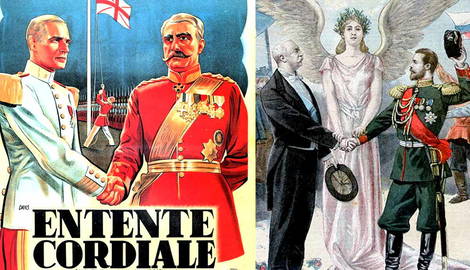
The July Crisis is usually described as a period of diplomatic and military escalations that followed the assassination of Archduke Franz Ferdinand, heir presumptive of the Austro-Hungarian Empire, in Sarajevo, on June 28, 1914. Ultimately, the actions of the Great Powers led to what we know today as World War I or the Great War. The question is — were the states really bound by their legal ties to start one of the bloodiest atrocities in history?
Military Alliances: The Central Powers and the Dual Alliance

To understand how the European stage got into such a complicated position, we shall first have a look into the particularities concerning the main actors involved. It is often believed that the military alliances established in the second half of the 19th century were instrumental in causing World War I. Two military blocks emerged resulting from the alliance system created between the Great Powers of that time: The Triple Alliance (also known as the Central Powers) and the Triple Entente.
The complicated relationship between the German and Austro-Hungarian Empires significantly improved after the Austro-Prussian War in 1866. The two Central European Empires sought to cement their new friendly relationship into a written agreement. A few years later, they co-opted the Kingdom of Italy into their alliance.
The first military block was established as a result of the Treaty and was concluded between the Austro-Hungarian Empire and the German Empire in October 1879 in Vienna. Even though the 1879 Treaty is generally interpreted as the first sign of the aggressive intentions of the two empires, it mainly had a defensive purpose. Thus, the treaty focused on mutual military aid between the two Germanic states in case of an attack by the Russian Empire. Moreover, the Treaty obliged none of the parties to engage in a war if the other contracting party was the one who initiated the hostilities.
The Triple Alliance and the Triple Entente

Later on, in 1882, a second defensive Treaty was concluded in Vienna between Germany, Austria-Hungary, and their new ally, the Kingdom of Italy. At that time, Italy’s frustration toward France became more and more intense as a result of the colonial ambitions of the two states in Northern Africa. The 1882 Treaty guaranteed military support from Germany and Austria-Hungary in case Italy was attacked by France without provocation. In turn, Italy was also obliged to support Germany in case of a French attack.
Referring to the “Russian problem”, the 1882 Treaty provided that in case of an attack by a non-signatory Great Power (including Russia), the other parties must join their ally in military action. As it can be easily inferred, none of the Treaties obliged their contracting parties to engage in a war provoked or initiated by one of their allies. Therefore, Germany’s decision to join Austria-Hungary in its war against Russia in 1914 could not be legally based on the provisions of these Treaties.
The second military block was formed in multiple phases, through separate agreements between the three Great Powers: The French Republic, the Kingdom of Russia, and the United Kingdom.
The Franco-Russian Alliance

The Convention between France and Russia was signed in 1892, seeking to counterbalance the significant power concentrated in Central Europe following the establishment of the Triple Alliance ten years earlier. The defensive nature of the Convention was underlined even from its preamble, mentioning that the purpose of the convention was: “a common desire to preserve peace, and having no other object than to meet the necessities of a defensive war.”
On the basis of the Treaty, France and Russia promised military aid in case of an attack by any of the Central Powers. Moreover, the two states were even obliged to mobilize their armies if any of the Triple Alliance states mobilized. What is interesting is the “link” between the Franco-Russian Convention and the Triple Alliance. Thus, Article 6 of the Convention provided upon its duration that: “The present Convention shall have the same duration as the Triple Alliance.”
Entente Cordiale

The series of agreements concluded in 1904 between France and the United Kingdom had limited military implications. Rather, the conventions signed at the beginning of April in Paris dealt with the colonialist agenda. Thus, the two states mutually recognized their spheres of influence in their African and Asian colonies, focusing especially on Egypt and Morocco. Even though the agreements did not have a military purpose, they set a new “friendly” tone for the relationship between the two former rivals.
The Anglo–Russian Entente

The Treaty of 1907 ended a long-time dispute between the United Kingdom and Russia in regard to Persia (Iran). The two empires split their Persian territories into two separate spheres of influence — the northern part was under Russian control, while the southern region was recognized as the British sphere of influence.
Similar to the previous Entente, the agreement did not have a military purpose, but rather sought to improve the relations between the two empires amid the increasing power of the rival states.
The Austrian Ultimatum to Serbia

The stage is set, the actors are ready, and we return to July 1914. Following the shocking assassination of Archduke Franz Ferdinand by the Serbian student Gavrilo Princip all eyes were on Austria-Hungary and its expected severe reaction. After a series of diplomatic discussions with its allies, the Dual Monarchy ultimately decided to express its official position in an ultimatum to the Serbian Government.
On July 23, 1914, the ambassador of the Austro-Hungarian Empire to Serbia, delivered the ultimatum act to the Serbian foreign ministry. Serbia had 48 hours to comply with all the provisions of the ultimatum. Without speaking about the extremely short deadline, from a legal perspective, the ultimatum was difficult for a sovereign state to accept and Austria-Hungary was most probably aware of this.
The “mild” provisions of the ultimatum obliged the Royal Government of Serbia to suppress the so-called “anti-Austrian propaganda.” In addition, the government had to proceed with the immediate dissolution of the nationalist organization “Narodna Odbrana,” which publicly protested against the annexation of Bosnia & Herzegovina by the Dual Monarchy.

Moving forward, the ultimatum urged cooperation between the Serbian and the Imperial authorities in the investigation regarding the June 28th assassination, as well as the arrest of two important Serbian military figures. However, the most problematic issue was point 6, which demanded that Austro-Hungarian delegates take part in the investigations carried out on Serbian territory. Serbia argued that such a provision undermined its sovereignty. It is generally agreed that point 6 was the only rejected provision by the Serbs.
The ultimatum did not expressly mention a sanction in case the Serbian Government would refuse to comply with all the provisions. However, when learning about the refusal of Serbia to comply with point 6, Austria-Hungary undertook the most severe sanction of all: The declaration of war, on July 28, 1914.
Escalations and Declarations of War

Things moved quickly after the first declaration of war made during the World War I. It was in this moment when all hopes for a localized war carried out only in the Balkans had faded. The first of the Great Powers to respond after Austria-Hungary’s declaration was Russia. The Empire ordered a partial mobilization of its divisions placed near the border with Austria-Hungary. However, the Great Powers were somehow circumspect at this stage in being the first to declare war one against each other, knowing that all the treaties concluded between them were exclusively defensive. In other words, nobody wanted to bear the responsibility of the war.
However, after the famous exchange of letters between the two cousins, Kaiser Wilhelm and Tsar Nicholas, failed to reach to an agreement, Russia declared a general mobilization of its army on July 30. Shortly after, Germany declared a general mobilization as well, starting its planned invasions of Luxembourg and Belgium.
As soon as the German army entered Luxembourg, the Kaiserreich declared war on Russia on August 1, 1914. Factually, this is the moment when a legal analysis of the network of alliances can be carried out.

It is obvious that the first country to start the aggression was Austria-Hungary, followed by a partial and, later on, general mobilization of Russia. Saint Petersburg was not legally bound to respond in any way to Austria’s attack on Serbia, as there was no treaty or agreement concluded between the two Slavic countries at that time.
In turn, Germany had no obligation to declare war on Russia at this stage. Article 1 of the Dual Alliance Treaty stated that, should “one of the two Empires be attacked by Russia, the High Contracting Parties are bound to come to the assistance one of the other.” On the other hand, it is more than obvious that Germany’s declarations of war on France and Belgium were even less justified.
The last key moment that somehow concluded the July Crisis was the British declaration of war on Germany on August 4. It came as a response to the German invasion of Belgium and its intended attack against France.

The Treaty of London was concluded in 1839 between Belgium and the Great Powers of that time, including France, Prussia, and Great Britain. Within the limits specified in the Treaty, Belgium was to form an independent and neutral State, guaranteed by all the signatory parties. Thus, Britain’s declaration of war was nothing else but an implementation of the Treaty’s provisions.









